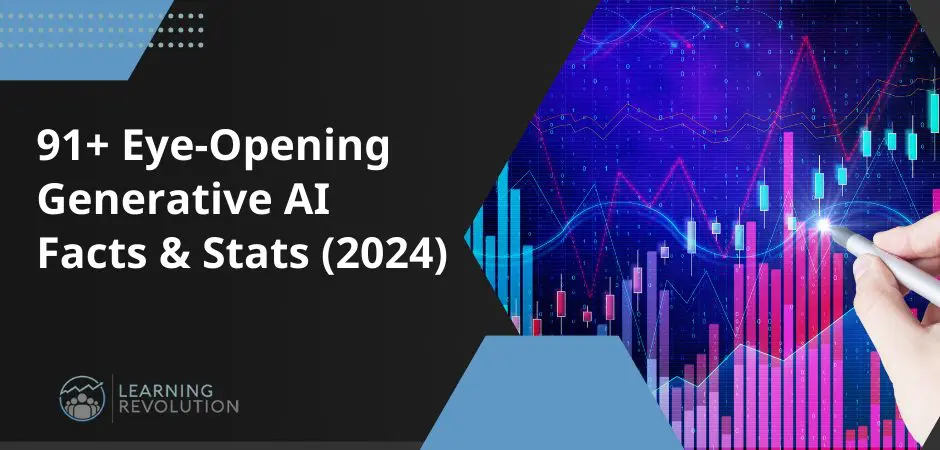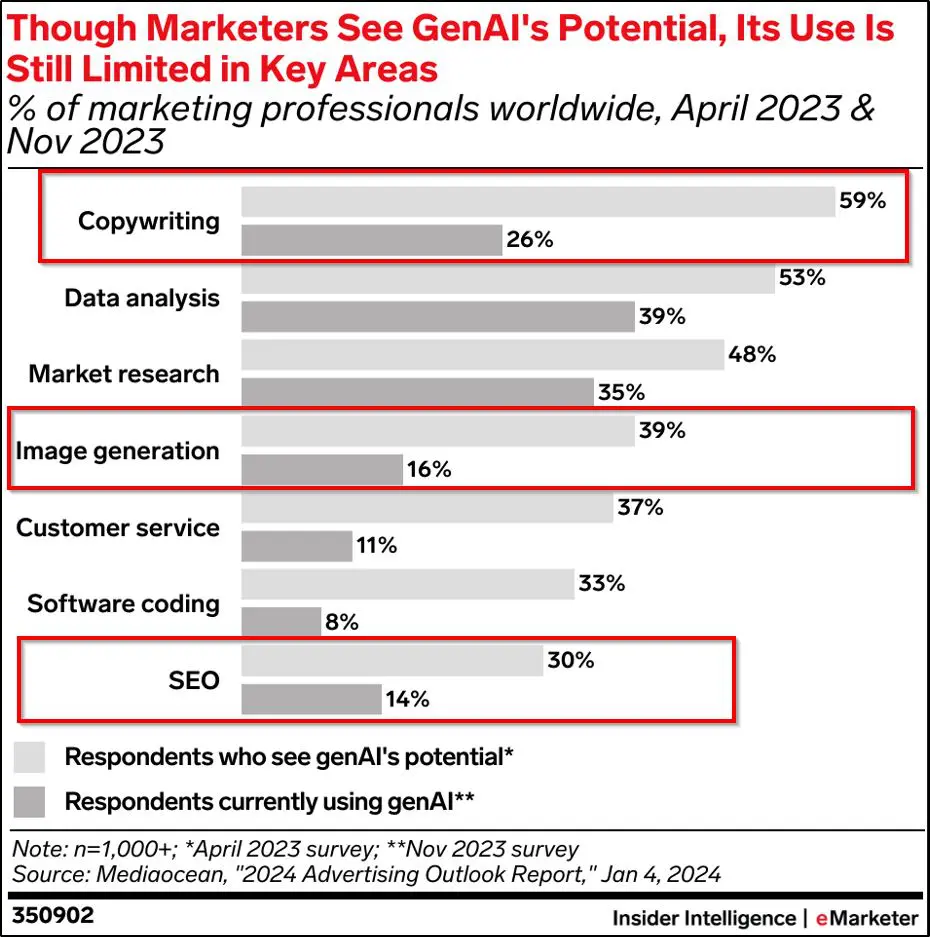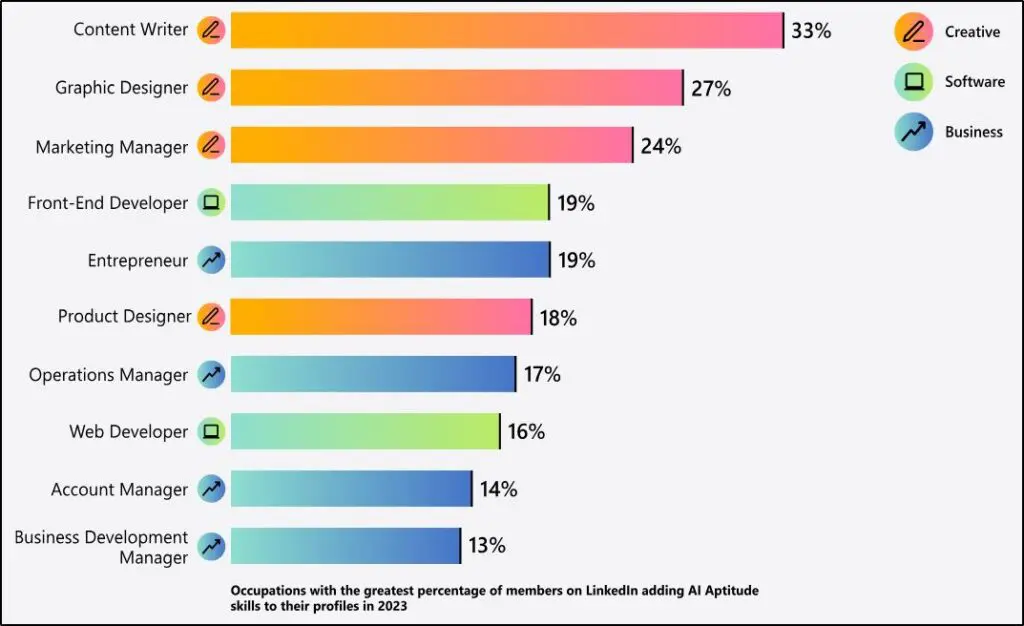
On November 30th, 2022, the world witnessed the true power of generative AI technology for the first time with the public launch of ChatGPT.
This moment didn’t just mark our entry into the AI age, it revolutionized how we approach marketing, content creation, and online learning.
Since that day, the landscape has evolved rapidly.
Tech giants like Google, Amazon, and Meta have joined the AI race, making complex generative AI technology more accessible to consumers and developers worldwide.
But how exactly has generative AI impacted content creation and online learning? Is it slowing down or just getting started? And how are marketers and creators leveraging AI tools in their businesses?
We’ve dived deep into original research, surveys, and studies from some of the world’s most credible institutions to curate dozens of stats that will answer all your questions about generative AI and show you where we’re headed.
Excited? Let’s jump right in.
Generative AI Overview: Market Size And Growth Forecast
- 2023 Market Size of $128 billion: The generative AI market will exceed $128 billion dollars by the end of 2024.
- 2032 Market Size of $1.2 trillion: The generative AI market will exceed $1.3 trillion by 2032 thanks to the explosion of tools in recent years such as Google Gemini, ChatGPT, CoPilot, Midjourney and others.
- OpenAI’s GPT-4 has emerged as the undisputed leader in the MMLU benchmark for generative AI models, achieving an impressive score of 86%.
- 90% of Americans have heard at least a little about artificial intelligence.
- 30% of U.S. adults can correctly identify specific uses of AI in everyday life.
These stats paint a clear picture.
Generative AI isn’t just a passing trend. It’s a transformative force reshaping the world around us.
We’re talking about a market set to skyrocket from $128 billion in 2024 to an astonishing $1.3 trillion by 2032.
This explosive growth is fueled by tools like Google Gemini, ChatGPT, and Midjourney, which are becoming integral to how we work and create.
It means that AI is no longer a futuristic concept, it’s already a part of our daily lives.
While 90% of Americans are aware of AI, only 30% can pinpoint its practical uses. This means if you’re proficient with generative AI technology, you already have a competitive advantage as a creator.
The ROI Of Using Generative AI Technology
Here are some eye-opening stats on the ROI of generative AI technology from a research report published by Google Cloud in Feb 2025.
- 74% of enterprises using gen AI report ROI within the first year.
- 86% of enterprises that report increased revenue, note an increase of 6% or more.
- 84% of organizations can move a gen AI use case from idea to production in less than six months.
- 63% of enterprises report that gen AI has directly driven business growth.
- 86% of Gen AI Leaders plan to allocate at least half of their AI future budget to gen AI.
- 47% of organizations plan to use gen AI to develop new products, services, and business models

ChatGPT And Other Leading Generative AI Tools
Let’s take a close look at the general statistics of some of the leading generative AI tools.
ChatGPT by OpenAI
- 60% market share: ChatGPT is the most popular generative AI tool with a 60.2% market share.
- 5 days to 1 million: It took ChatGPT just 5 days from its public launch to reach 1 million users.
- 2 billion+ monthly visitors: Over 2.4 billion people visited the ChatGPT website in June 2024.
- 6 minutes avg. session time: The average ChatGPT website visitor stays on the site for 6 minutes and 4 seconds.
- 86% user retention in the US: 86% of adult artificial intelligence (AI) tool users in the United States stated they would use ChatGPT again.
- 15% US traffic: The highest percentage of ChatGPT users (15.87%) comes from the USA, followed by India (9.61%) and Brazil (5.74%)
Google Gemini
- 370 million visitors: Google Gemini has over 370 million visitors to its desktop website in May 2024.
- 5 minutes and 13 seconds is the average visit duration of a Google Gemini user.
- 500K+ app downloads: Google’s Gemini AI Assistant mobile app registered around 554,000 downloads on the App Store and Google Play Store in June 2024.
Microsoft Copilot
- 75 million PC users: According to the investor brief by Satya Nadella, Microsoft CEO, Copilot in Windows is available on over 75 million PCs worldwide.
- 1.3 million GitHub Copilot users: Over 1.3 million professionals use GitHub Copilot, which is owned by Microsoft.
- 70% productivity boost: Copilot users experienced significant productivity gains, with 70% reporting improved productivity.
- 29% faster task completion: Copilot users completed tasks 29% faster than those without Copilot.
- Saves over 4 hours a month: Copilot users report an average daily time savings of 14 minutes, which translates to 1.2 hours of saved time per week.
- 64% faster email processing: Copilot helped 64% of users reduce the time spent processing emails.
- 85% faster first drafts: Copilot helped 85% of users create first drafts more quickly.
Meta AI
- Meta AI is available to WhatsApp users in 22 countries (April 2024 update).
- 4 billion users worldwide can access Meta AI via WhatsApp, Facebook, Instagram, and Messenger. However, the exact number of Meta AI’s active users is still unknown.
AI Image Generators
- 56% of influencers use Canva for AI Images: Canva is the most popular AI image generation tool among influencers with 56% saying it’s their first choice.
- 639.7 million Canva visitors: In July 2024, Canva’s website got more than 639 million visitors.
- 20 million+ Midjourney users: Midjourney is among the most robust AI-image generation tools with over 20 million registered users on its Discord servers.
ChatGPT is by far the most popular generative AI tool. But others are making big strides.
Gemini, Meta AI, and Copilot are steadily improving their technology by introducing faster and more intelligent models.
Unlike ChatGPT, these AI tools are embedded in popular browsers, operating systems, and communication apps. Which means they’re instantly available to billions of users worldwide.
Remember these stats don’t cover the countless generative AI tools and products built using the APIs and publicly available technology of these platforms.
To get a sense of what’s possible, check out our list of the best Generative AI tools for content creators.
The Impact of Generative AI Tools On e-Learning And Online Creator Industries
- $500 billion: The potential impact of the creator economy by 2027.
- 4 learners/minute (2024): Coursera reported that on average four learners sign up for a generative AI course on the platform every minute in 2024. This is a 4x increase from 2023 when 1 new learner signed up for a Gen AI course every minute.
- 1,060% growth in Gen-AI course enrollments: Coursera saw massive growth in generative AI course enrollments.
- 72% (male) vs. 28% (female): Most new learners enrolling in GenAI content on Coursera are male.
- 57% of trainers have seen a positive impact on completion rates of training courses with AI video.
- 68% of trainers have seen a positive impact on learning satisfaction scores with AI video.
- 53% agree AI improves content quality: In a survey of over 1000 podcasters and video creators, 53% said using Gen-AI tools improved their content quality.
- 52% of podcasters and video creators in a survey said Gen-AI tools helped them become more creative.
- 43% of Learning & Development professionals claim AI tools have replaced traditional video production processes in their organization.
- 75% of L&D trainers started creating AI videos because it’s faster and more convenient.
- 62% faster video production: AI tools have reduced training video production time by 62% (from 13 days to 5 days).
- 58.21% of YouTube creators who use generative AI tools, do so to create new content (texts, images, videos, audio).
- 40.30% of YouTube creators who use generative AI tools, do so to enhance existing content.
- 41.79% of AI content creators on YouTube primarily use ChatGPT and DALL.E for text and image generation.
- 37.31% of YouTube videos analyzed in an AI content study by Pennsylvania State University (PSU) were created using tools like Adobe Premiere Pro and Pictory.
- 16 million+ AI-related posts on Instagram: As of August 2024, Instagram had over 16,144,096 posts with the hashtag #AIart, indicating the explosive rise of AI content on the platform.
- Over 6 million Instagram posts contained the hashtag #AIartcommunity, used by active AI content creators on Instagram, at the start of August 2024.
Generative AI is already transforming the online learning and content creation industries.
As an online course creator, it’s crucial to recognize that your audience now has direct access to information on almost every topic.
This means that even someone with little practical experience can create an online course, eBook, or digital product in your area of expertise.
You’re likely seeing this trend on platforms like Amazon, Udemy, and others.
But rather than viewing it as a threat, see it as an opportunity to truly stand out.
If you’re a real expert, differentiate yourself by going beyond theoretical knowledge. Infuse your courses and digital products with personal experiences, practical advice, and scenario-specific content that helps your audience achieve clear, well-defined goals.
Leverage AI tools to accelerate your course creation process, but don’t stop at just selling information.
Build loyal communities around your products, allowing your customers to engage directly with you. Solve their problems and establish yourself as a reliable mentor.
Remember, no AI tool can replace your personal insights and experiences, make them count.
Consumer Behavior And Perception Regarding AI-Generated Content
- 49% of consumers have or would consume content they knew was created by AI.
- 65.8% of people think AI content is equal to or better than an average human writer’s content.
- 78% of creators believe AI-generated content is here to stay.
- 50% of consumers can correctly identify copy that is AI-generated.
- American consumers are 10% more likely to spot when content is AI-generated than UK consumers.
- 56% of consumers preferred AI content over human-written content when they were unaware of the content source.
- 52% of consumers said they felt less engaged when they knew the content was AI-generated.
- 20% of consumers considered a brand lazy if it used AI content for its website’s homepage.
- 26% of consumers feel a brand is impersonal if the copy does not feel human-written.
- 45% of consumers consider a brand impersonal and untrustworthy if its social media content is AI-generated.
- 19% of consumers consider a brand uncreative if they detect AI content on their social media profiles.
- Millennials (born between 1981 and 1996) are most likely to differentiate between AI and human-written content.
- 22% of Americans say they interact with gen AI tools almost constantly or several times a day.
- 63% of postgraduates and 57% of college graduates interact with generative AI tools at least several times a week.
These stats show that nearly half of all consumers are open to engaging with AI-created content, and a significant majority believe it’s on par with or better than what a human writer might produce.
But here’s where it gets tricky.
While AI content is becoming more prevalent, it’s not without its challenges. Consumers are becoming increasingly savvy, with many able to identify when content is AI-generated.
This can impact their trust and engagement with your brand.
As a creator or marketer, this means you need to strike a balance.
While AI can help you produce content more efficiently, over-reliance on it could risk making your brand seem impersonal or untrustworthy to a significant portion of your audience.
Especially on key touch points like your website’s homepage or social media, where authenticity and creativity are crucial, it’s essential to blend AI with your unique voice and personal touch.
Remember, while AI is a powerful tool, your audience still values the human element that only you can provide. Use AI to enhance your content, but don’t let it replace the genuine connection you can offer.
How Marketers And Creators Use Generative AI Tools
- 75% of knowledge workers actively use generative AI tools in their routine tasks.
- 59% of marketers see potential for generative AI in copywriting but only 26% use it for that purpose.
- 39% of marketers see the potential for AI images in marketing but only 16% actually use it.
- 30% of marketers believe Gen AI can play a role in SEO but only 14% use it for that purpose.

- 50% of enterprise marketers in the US leverage AI for personalization in their email marketing campaigns.
- 47% of email marketers use AI tools to optimize their email subject lines.
- 98.1% of marketers believe that some understanding of AI is important for their jobs
- 14% of organizations expect generative AI to transform their companies immediately (within 6-12 months).
- 36% of organizations expect generative AI to bring about transformation within 1-3 years.
- 50% of organizations do not expect generative AI to transform their companies before 1 year.
- 71% of marketers expect generative AI will help eliminate busy work and allow them to focus more on strategic work.
- 76% of marketers use generative AI tools for writing marketing copy.
- 45% of B2B marketers use gen AI to research headlines and keywords for content optimization.
- 33% of content writers and copywriters, 27% of graphic designers, and 24% of marketing managers say they’re well-versed in using generative AI tools.

- 71% of sales professionals use AI tools to automate and personalize customer communication.
- 72% of B2B content marketers use generative AI tools like ChatGPT, Bard, and Co-Pilot.
- 51% of content marketers use generative AI to brainstorm new topics
- 45% of content marketers use generative AI tools for writing content first drafts.
- 64% of PR professionals use generative AI tools for writing social media copy.
- Only 11% of B2B marketers use gen AI tools for image creation.
Marketers and content creators are usually the fastest to adopt new technology. So, it’s not surprising that most marketers consider Gen AI critical for their future work.
But there’s still a gap between AI’s potential and actual use in marketing.
This is probably because despite generating impressive text and image content, generative AI tools still lack the quality and uniqueness of a real expert.
But that doesn’t mean marketers aren’t using it at all.
AI is already making a difference in email marketing and content creation. By automating repetitive tasks, AI frees you up to focus on being creative and strategic.
The key is to use AI as a tool to enhance your work, not replace your unique voice and expertise.
As a course creator, you have the chance to stay ahead by incorporating AI where it makes sense, allowing you to create more impactful content and connect better with your audience.
The Risks And Concerns About Using Generative AI
- 31% of marketers feel concerned about the accuracy and quality of AI content.
- 36% of B2B marketers don’t use generative AI because of accuracy concerns.
- 56% of B2B marketers say creating the right content for their audiences is their biggest concern.
- 61% of organizations lack guidelines for using generative AI tools
- 39% of sales professionals fear losing their jobs if they do not learn to use Gen AI tools efficiently.
- 50% of marketers have some concerns about AI replacing their jobs.
- 53% of people who use AI at work worry that using it on important work tasks makes them look replaceable.
- 74% of US consumers cite personal data security and privacy as their biggest concerns about gen AI technology.
- 63% of US consumers are concerned about potential bias and discrimination in AI-generated content.
- 52% of Americans are more concerned than excited about AI in daily life.
- 35% of high school teachers say generative AI tools do more harm than good for student learning.
- 54% of Americans say generative AI programs need to credit the sources they rely on.
- 75% of Americans say AI programs should credit sources if they provide information matching a journalist’s work nearly word-for-word.
- 67% say AI programs should credit sources if they generate images imitating an artist’s style or text imitating an author’s style.
- Engineers at Columbia University have developed a new tool called DIVID (DIffusion-generated VIdeo Detector) that can detect AI-generated videos with up to 93.7% accuracy.
One thing’s clear from these stats.
Despite all the advancements, consumers still don’t fully trust generative AI technology.
This only confirms what I’ve been saying throughout this post.
Your expertise, personal experiences, and unique voice are irreplaceable as a course creator and mentor.
Don’t underestimate your value just because an AI chatbot can generate text information faster than you.
Serious learners still want a personal connection and real-world advice from a genuine expert.
So, while you should certainly embrace AI technology, don’t let people perceive you as lazy or unreliable by using AI-generated content without any value addition.
Data Sources: McKinsey, Statista, Fortune Business Insights, SimilarWeb, MarketBeat, Salesforce, Thinkific, Bynder, Synthesia, eMarketer, Pew Research, Discord, Microsoft, Columbia University, PSU, SMA Instagram Facts, WhatsApp, Descript, Coursera, Work Trend Index, Google Cloud
See Also:
- 22 Best Generative AI Tools List For Content Creators (2024)
- 13 Generative AI Use Cases For Course Creators [With Examples]
- 16 Best AI Image Generator Apps For Creators (Free & Paid)
- 9 Ways To Humanize AI Content
- Eye-Opening Bootcamp Course Market Statistics (2024)
- 40+ 2024 Elearning Statistics for Course Creators
Table of Contents

Related Posts
Eye-Opening Bootcamp Course Market Statistics